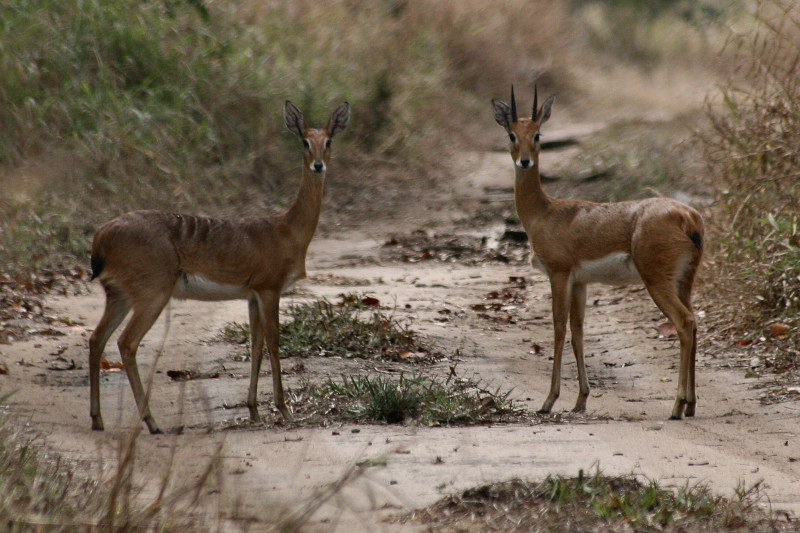Oribi Facts
- This beautiful small variety of antelope goes by the short common name of the Oribi. For the moment, the remarkable mammal has no alternate common term. Its scientific name, meanwhile, is the the short yet hard to pronounce term of the Ourebia ourebi.
- It owes that name to the individual who accomplished the first formal recognition of it as a distinct species. This action occurred in 1783. It took place as a result of the work of the renowned German zoologist Eberhard August Wilhelm von Zimmermann.
- Presently, this marvel of Nature represents the only member of its genus. A number of recognized subspecies do exist, however. At present, researchers acknowledge a total of eight of these subspecies. More of these could potentially be recognized.
- As a species, this animal currently stands on a cusp concerning its status. That’s partly because, for now, the IUCN lists it as a Species of Least Concern, on its Red List. It holds that status due to the fact that it still has a relatively sizeable population base.
- That base, however, appears to be declining rapidly. At present, this unfortunate trend derives from local human actions. More specifically, agricultural expansion by man has adversely affected it. It further now faces competition from livestock for food.
- These now pose a threat to the Oribi on a local scale. The reduction on habitat from the expansion of agricultural efforts does so especially. These facts, however, only serve to potentially make it even more vulnerable to the effects of climate change.
Related Articles
Oribi Physical Description
The magnificent Oribi enthralls those who see the creature with its distinctive appearance. It also bears noting for another reason. That has to do with its sheer size That holds true due to the fact that this wonder of evolution represents a small variety of antelope.
Like many types of mammals, it also displays a moderate degree of the physiological trait of sexual dimorphism. In its specific case, though, this trait manifests itself in two ways. The first, no surprisingly, is in terms of simple physical size, like most of its relatives.
More precisely, females of the species generally attain a slightly greater height and weight. Overall, however, the animal achieves a shoulder height of 20 – 26 in (50 – 67 cm). An average head-and-body length, meanwhile, measures roughly 36 – 43 in (92 – 110 cm).
Its body weight represents the greatest variable, though. Most specimens reach a weight of between 26 – 49 lb (12 – 22 kg). This range, however, appears to have no relation to the gender of the individual. Individuals also possess a relatively short, thin tail.
The other form of gender based physical variation the Oribi displays occurs on the head. That’s because the males develop a pair of horns, while the females do not. These develop as thin, straight, and short. These range in length from 3.1 – 7.1 in (8 – 18 cm).
The two genders remain otherwise similar in appearance. Both develop a thin body, long limbs and neck. Both also display a slightly raised back. Most of the coat displays a glossy dark yellow to light brown color. The throat, chin, rump, and belly are white.
- Kingdom: Animalia
- Phylum: Chordata
- Class: Mammalia
- Order: Artiodactyla
- Family: Bovidae
- Genus: Ourebia
- Species: O. ourebi
Oribi Distribution, Habitat, and Ecology
The awesome Oribi possesses a moderately broad range. That’s because the somewhat small mammal evolved as endemic to a specific portion of the continent of Africa. Unfortunately, though, that range of habitation also qualifies as highly sporadic in nature.
More precisely, it appears in the western, southern, and eastern sections of the continent. Within that region, its territory extends from Nigeria and Senegal in the west. From there it reaches through Eritrea in the east, then south to Angola and the Eastern Cape.
Luckily, however, within that range it evolved as highly adaptable in terms of habitat. Due to that, the animal thrives in a multitude of habitats. These include regions of tropical grasslands, floodplains. It seems most prevalent, though, in areas of savannah.
It further lives at a wide range of altitudes. Populations appear from low altitude ranges up to as high as 6,600 ft (2,00 m) above sea level. Its most important criteria for where it dwells seems to be the presence of cover sufficient to hide it from its predators.
The marvelous Oribi further evolved as diurnal in nature, meaning its mainly active during the day. Individuals do occasionally display activity at night as well, though. The animal also prefers to remain under cover during periods of locally heavy rain.
Like most of its relatives, the delicate beauty evolved as a herbivore. In its case, it feeds primarily as a grazer. Individuals principally feed on various locally available fresh grasses. About 10% of its diet, however, consists of mushrooms and various flowers.
Species Sharing Its Range
Check out our other articles on 3 Magnificent North American Eagles, Crocodilefish, Bungle Bungles, Giant Girdled Lizard, Death Apple Tree, Mormon Metalmark, Indian Bullfrog

